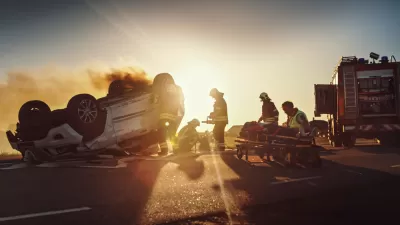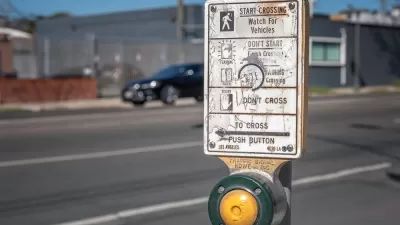Rates of traffic deaths vary widely among racial and economic groups but continue to rise across the board.

Although car crashes might seem like “an equal-opportunity public health problem,” David Leonhardt, writing in the New York Times, highlights the stark inequalities among economic and racial groups as traffic deaths rise sharply across the country.
Although traffic death rates were steadily declining since the 1970s, they started growing again in 2015, partly due to the ubiquity of smartphones and, consequently, distracted driving. “The U.S. has also been less aggressive about cracking down on speeding than Britain and some other parts of Europe, and vehicles here tend to be larger.” Since the pandemic began, road deaths rose even more dramatically.
As to the reasons for the inequity in traffic deaths, Leonhardt writes, “Poorer people are more likely to drive older cars, which can lack safety features. Low-income neighborhoods are also much more likely to have high-speed roads running through them.” And while some Americans were able to work from home during the pandemic, “many blue-collar Americans kept driving, biking or walking to work.”
Whatever the reasons for the growth in crashes, there are many known, simple solutions that safety advocates have touted for decades. As Leonhardt explains, “Those answers include: stricter enforcement of speed limits, seatbelt mandates and drunken-driving laws; better designed roads, especially in poorer neighborhoods; more public transit; and further spread of safety features like automated braking.”
FULL STORY: Race, Class and Traffic Deaths

Alabama: Trump Terminates Settlements for Black Communities Harmed By Raw Sewage
Trump deemed the landmark civil rights agreement “illegal DEI and environmental justice policy.”

Planetizen Federal Action Tracker
A weekly monitor of how Trump’s orders and actions are impacting planners and planning in America.

The 120 Year Old Tiny Home Villages That Sheltered San Francisco’s Earthquake Refugees
More than a century ago, San Francisco mobilized to house thousands of residents displaced by the 1906 earthquake. Could their strategy offer a model for the present?

In Both Crashes and Crime, Public Transportation is Far Safer than Driving
Contrary to popular assumptions, public transportation has far lower crash and crime rates than automobile travel. For safer communities, improve and encourage transit travel.

Report: Zoning Reforms Should Complement Nashville’s Ambitious Transit Plan
Without reform, restrictive zoning codes will limit the impact of the city’s planned transit expansion and could exclude some of the residents who depend on transit the most.

Judge Orders Release of Frozen IRA, IIJA Funding
The decision is a victory for environmental groups who charged that freezing funds for critical infrastructure and disaster response programs caused “real and irreparable harm” to communities.
Urban Design for Planners 1: Software Tools
This six-course series explores essential urban design concepts using open source software and equips planners with the tools they need to participate fully in the urban design process.
Planning for Universal Design
Learn the tools for implementing Universal Design in planning regulations.
Clanton & Associates, Inc.
Jessamine County Fiscal Court
Institute for Housing and Urban Development Studies (IHS)
City of Grandview
Harvard GSD Executive Education
Toledo-Lucas County Plan Commissions
Salt Lake City
NYU Wagner Graduate School of Public Service





























